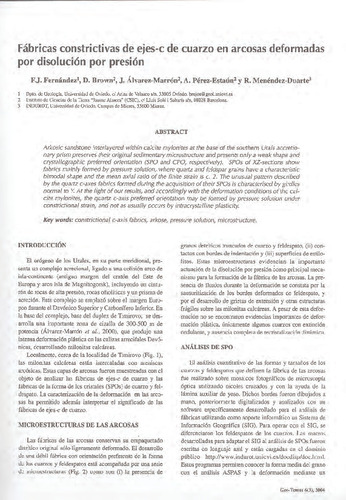Fábricas constrictivas de ejes-e de cuarzo en arcosas deformadas por disolución por presión
Subject:
constrictiona/ e-axis fabrics, arkose, pressure solution, microstructure
Publication date:
Editorial:
Sociedad Geológica de España
Citación:
Descripción física:
Abstract:
Arkosic sandstone interlayered within ca/cite mylonites at the base of the southern Ura/s accretionary prism preserves thefr original sedimentary microstructure and presents only a weak shape and crystal/ographic preferred orientation (SPO and CPO, respective/y). SPOs of XZ-sections show fabrics mainly formed by pressure so/ution, where quartz and feldspar grains have a characteristic bimoda/ shape and the mean axial ratio of the finite strain is c. 2. The unusual pattern described by the quartz e-axes fabrics formed during the acquisition of their SPOs is characterised by girdles normal to Y. At the light of our results, and accordingly with the deformation conditions of the ca/cite mylonites, the quartz e-axis preferred orientation may be formed by pressure solution under constrictiona/ strain, and notas usual/y occurs by intracrystalline p/asticity.
Arkosic sandstone interlayered within ca/cite mylonites at the base of the southern Ura/s accretionary prism preserves thefr original sedimentary microstructure and presents only a weak shape and crystal/ographic preferred orientation (SPO and CPO, respective/y). SPOs of XZ-sections show fabrics mainly formed by pressure so/ution, where quartz and feldspar grains have a characteristic bimoda/ shape and the mean axial ratio of the finite strain is c. 2. The unusual pattern described by the quartz e-axes fabrics formed during the acquisition of their SPOs is characterised by girdles normal to Y. At the light of our results, and accordingly with the deformation conditions of the ca/cite mylonites, the quartz e-axis preferred orientation may be formed by pressure solution under constrictiona/ strain, and notas usual/y occurs by intracrystalline p/asticity.
ISSN:
Patrocinado por:
BTE 2002-00187 y ERC FMRXCT 960009
Files in this item




